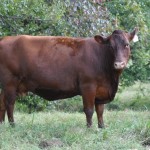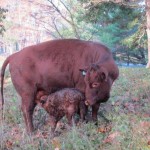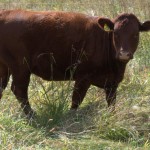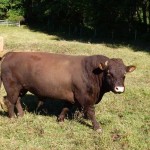A ‘foundation cow”….
 ….is not a designation we use in the “Devon world”. But if we did, R2 would certainly merit the honor. Purchased almost as an afterthought from Lakota Ranch seven years ago, she has been a steady star performer.
….is not a designation we use in the “Devon world”. But if we did, R2 would certainly merit the honor. Purchased almost as an afterthought from Lakota Ranch seven years ago, she has been a steady star performer.
R2 comes from the same Lakota family that sired a top Devon bull, “Bud”, who became a star performer for Bill Roberts. That line is almost as prevalent in our herd as Rotokawa.
 R2‘s daughter, T2, by Rotokawa 93, has maintained the momentum. Visitors often ask to reserve a future calf by her or pay for a flush, which we politely decline. T2‘s latest is this heifer, X2a, pictured at birth. But the next is due any day and may have arrived by the time you read this.
R2‘s daughter, T2, by Rotokawa 93, has maintained the momentum. Visitors often ask to reserve a future calf by her or pay for a flush, which we politely decline. T2‘s latest is this heifer, X2a, pictured at birth. But the next is due any day and may have arrived by the time you read this.
It’s interesting that our “2s” tend to stay together in the herd…as does another Lakota line, the “3s” and they all continue to calve at the same time and immediately bond. Find one, and you’ve found them all!
 X2a is now just over two and has just been bred to a promising English bull, TDA Churchill. Not to count our calves before they’re hatched, but the results of that breeding will have to remain in our herd until the Traditional Devon America partners agree to start releasing those genetics. An important point in all this is how indebted Devon breeders are to each other.
X2a is now just over two and has just been bred to a promising English bull, TDA Churchill. Not to count our calves before they’re hatched, but the results of that breeding will have to remain in our herd until the Traditional Devon America partners agree to start releasing those genetics. An important point in all this is how indebted Devon breeders are to each other.
 Incidentally, R2 produces bulls every bit as good as she does females. U2 gave us more good calves than any bull we’ve ever used. Descended from Rotokawa 974, there’s no doubt that he brought us to “the next level. Our plan is to use him one more time this Fall and then make him available to other breeders. There’s a younger half-brother coming along who deserves the opportunity to make his mark.
Incidentally, R2 produces bulls every bit as good as she does females. U2 gave us more good calves than any bull we’ve ever used. Descended from Rotokawa 974, there’s no doubt that he brought us to “the next level. Our plan is to use him one more time this Fall and then make him available to other breeders. There’s a younger half-brother coming along who deserves the opportunity to make his mark.
But the “2’s” have firmly put their stamp on the Thistle Hill herd and will always have a special place in our hearts. Of course there are some other great cow families in our herd as well—31, R6, R3, 64, 180—and we’ll be profiling them in coming days.
4 Comments
mike ortwein
I am surprised you calve in the fall, out of sync with nature. How many bulls do you have, and How do you manage to move your cows every day, keep track of who bred who? How many herds do you move each day? I have two bulls and two herds that I move each day, in the winter I combine the two herds but separate the bulls out and the two become my second herd–and if I have enough pasture I move those two every day. Might make it this year with no hay.
David
Because of the heat, and the prevalence of endophyte-infected fescue it is best for us to calve in synch with the second best time….the Fall. We’ve found a number of benefits to that including far better animal performance, easier re-breeding, and 100% calf crops.
Because we sell bulls as well as females, we need to keep an inventory of several lines…in several generations. Right now we have bulls isolated in three separate pastures. Of course, we only put one bull in with a group of cows, but we still DNA to make sure there’ve been no visitors. If there’s a bull we want to “test”, we’ll break out cows from the herd and put them in their own pasture.
Our breeding-age heifers are moved every two days with the chosen bull right with them. The main herd, which is beginning to calve, is being held in place and will be moved to fresh grass when calving is complete. At that time we separate the herd in two—bring in the appropriate bulls (2) so that mothers and sisters aren’t re-bred. If we decide to line breed, we use AI or embryo flushes.
Normally, with the main herd, we move every two or three days.
Hope I’ve made this clear enough. We make a number of “adjustments” in all the theories to match our environment and property…and our age. And we find it easier to help would-be customers by not over-whelming them with too many animals at the same time. So if you’re looking for cows, they’re over here. Open heifers, over there. Bred heifers, there. Etc. If I were in just the meat business, I would have a simpler arrangement.
Finally, I keep everything clear in my mind by just asking Wooz!
Eric Smith
What dates does it usually work out for you to put in your bulls and remove them? I am considering (and so are my cows!) moving to fall calving as well.
Also, are there any issues with leaving a bull with cows when they’re calving?
David
Eric, generally we put the bulls in during Christmas week and pull them out 45 days later…up to 66 days if they’re re-breeding first-calf heifers. That’s two (or 3) cycles which should be fine for any cow you’d want to keep. We’ve never had a problem having bulls in with calving cows though it’s not something that generally happens here.